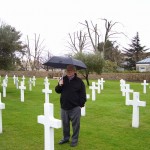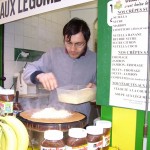THE RIVERS OF FRANCE
This is the second in a series of articles about a boat trip along the Rhone River
TRAVELING IN PROVENCE
By Charles N. Stevens
Photos by Dolores Seidman
We wake up to a gray, mottled sky, rain peppering down on our balcony, the houses on the hillsides dimmed in mist. Close by, the sing-song wailing of an ambulance echoes among the buildings. Seagulls wheel over the rooftops mewing like unhappy cats.
Ready to go now, we sit on the bus that will take us to Aix-en-Provence and eventually Avignon. The slow rhythm of the windshield wipers clears the view ahead as we wait for the last of our group. Outside, people walk briskly along the wet sidewalks, their colorful umbrellas like a moving flower garden.
We begin our trip along the bay, this morning dull gray compared to the brilliant blue of yesterday afternoon. I notice how bright neon signs look on the rainy morning. We travel on the Boulevard d’Anglais, the boulevard of the English, named for them as they once spent much of their vacation time in Nice, the French Riviera. Later it was the Americans who crowded into Nice, then the Arabs with their oil money and even later the Russians, said to be rich because of the flourishing black market.
When we pass through the town of Antibe we enter Provence, the portion of France once occupied by the Romans over two thousand years ago. The Romans “civilized” the original Celtic people and built great cities, the ruins of them scattered all over southern France.
The freeway we travel skirts the city of Cannes, home of the famous Cannes film Festival. We pass round Mediterranean pines and acres of dormant vineyards, the first of their leaves weeks away.
We stop at the American Military Cemetery at Draguignan where Americans killed in the invasion of southern France are buried. The invasion began on August 15, 1944 though Toulon and St. Trope. Over nine hundred crosses bearing the names of the soldiers lie in rows here, even though some of the bodies have been reburied in the United States. I wander among the crosses reading their names, the raindrops ticking on my raised umbrella. I feel my throat tighten and suppress a few errant tears. In a small ceremony in the cold but beautiful chapel, light filtering through from a stained glass window, I and one other veteran lay a wreath of flowers on the altar.
On our way again our guide points out Mt. St. Inflatable Water Slide Victoire in the distance, the mountain that the artist Paul Cézanne often depicted on his canvasses. Most of the houses we pass are tan, buff, beige or mustard, their geometric grouping with the hills behind resembling a Cézanne painting.
By the time we reach Aix-en-Provence the clouds have rolled off to the east, and the sun floods the streets of the city. Severely trimmed plane trees, standing bare like great bleached bones, line the streets. Long louvered shutters of every color flank all the windows, adding gaiety to the narrow streets.
I zip up my jacket against a cold wind as we amble through the streets of the town. Hearty students eat salads outdoors despite the chill. Others dine outside in high wicker chairs, the sun gleaming on their wine glasses, unfazed by the wind. An accordion player pumps out his rendition of La Golondrina, the notes echoing sweetly down the narrow streets. We pass the usual boulangeries (bakeries), patisseries (pastry shops), and charcuteries (delicatessens), always neat, tasteful and tempting. Under a twelfth century tower a plaque commemorates the American liberation of the town in 1944.
Hungry, Dolores and I walk back up the street to order crepes from a vendor who has a window opening out on to the street. I order a cheese crepe and Dolores ham. He pours out the pale batter onto a round griddle then uses a T-stick to smooth it out and cover it evenly. When he finishes them and includes their filling he wraps them in paper plates, the warmth of them feeling wonderful on our cold hands. We sit on the edge of a fountain devouring our first French lunch.
On our way again our bus zooms through the constricted roads of Mouries and out into miles of pink blossomed cherry trees, most of the orchards separated by tall rows of poplar trees. Sheep graze in the green fields. A side trip takes us up to Chateau de Baux, a crumbling gray castle, almost indistinguishable from the gray rock upon which it perches.
After rolling by many olive groves we come to the city of St. Remy de Provence where the painter Vincent Van Gogh once entered a sanitarium to cure his mental problems.
We approach Avignon in an almost impossible traffic jam, this problem now becoming universal. The road follows the old but still intact city walls, gradually leading us to the Rhone River and the small ship that will be our home for over a week. Originally we were to meet our ship at Arles, but because the Rhone is flowing higher than normal it seemed safer to board in Avignon.
We settle into our ample stateroom, put our clothes away in closets and drawers, and look ahead to our journey along the Rhone.

Standing among the crosses of Americans killed in Southern France is an emotional experience.

By the time we reach Aix-en-Provence with its trimmed back trees sun floods the streets.

We enjoy crepes stuffed with ham and cheese at a stand at Aix-en-Provence.




Wonderful article! Makes one want to be right there, too.